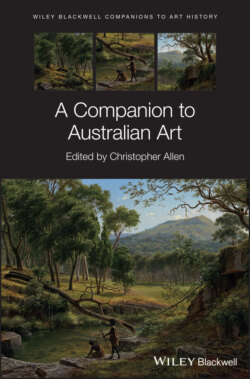Читать книгу A Companion to Australian Art - Группа авторов - Страница 13
II – Dwelling in Australia
ОглавлениеThe second section of the book deals with the period leading up to Federation in 1901. Australia was, until that point, made up of separate colonies, each emerging at different periods and evolving at different rates, and all gradually becoming self-governing entities that liked to think of themselves as distinct nations until they were eventually persuaded to become states within a federal nation, the Commonwealth of Australia. Both because of the separate histories of the colonies and because of their own view of themselves as autonomous centers, it is logical, as already mentioned, to discuss the development of each in a separate chapter.
The first of these chapters, by Richard Neville, is accordingly devoted to Sydney, the earliest colony established in Australia in 1788, the year before the French Revolution, and a time when the nearest outpost of European civilization was the Dutch city of Batavia, far to the north. The next chapter, by David Hansen, examines the second colonial center, established soon after Sydney, at Hobart in Tasmania, and Tasmania more generally; between them, these two cities have the oldest European heritage in Australia, with numerous buildings that date back to the Georgian period, and a culture marked by memories of the convict period. Convict transportation was, on the whole, a more humanitarian alternative to the death penalty, and ended up being a largely successful experiment in social rehabilitation; but it also had many darker aspects in the shorter term. Thus New South Wales and Tasmania are also the places most notably marked, especially in the case of Tasmania, by early and often bloody conflict between largely ex-convict settlers and the indigenous population.
The story of Melbourne, discussed in a chapter by Ruth Pullin which focuses particularly on the career of Eugene von Guerard, was a very different one: the city was founded several generations after Sydney, in the later 1830s and 1840s, and was almost immediately supercharged by the vast wealth of the Gold Rush, so that in the second half of the century Melbourne grew far bigger and richer than Sydney – setting the scene for a rivalry between the two main cities of the continent that has never abated since. One of the forgotten aspects of Melbourne’s history was the preponderance of German immigrants among its mid-nineteenth century intelligentsia; with the outbreak of the Great War, German Australians were interned and many subsequently left. In the climate of anti-German feeling then and later, their contribution to the history of the colony was played down or deliberately overlooked.
Adelaide’s story, told in Jane Hylton’s chapter, is different again. It was neither a convict city like Sydney nor a Gold Rush boomtown like Melbourne, but a carefully planned colony designed for free settlers who arrived with a minimum of capital to invest in its building. Adelaide remains the only important city in Australia never to have had a convict population – Perth, in Western Australia, was also founded as a free city but was subsequently forced to ask for shipments of convicts because of a shortage of labor.
Like Victoria, Queensland, discussed in a chapter by Glenn Cooke, was formed by separation from the originally vast territories of New South Wales. Queensland consists largely of an enormously long coastal strip of settlements running from Brisbane in the sub-tropical south of the state up into the Tropic of Capricorn, together with a largely arid and barely-inhabited hinterland. Brisbane has never rivalled Sydney or Melbourne as a cultural center in Australia, partly because so many Queenslanders with intellectual or cultural interests have, in the past, moved to one or other of the bigger cities. But Brisbane began to assert itself more effectively towards the end of last century, aided by the growing importance of Australian connections with Asia, to which it is closer than the southern capitals.
The next chapter in this section is thematic rather than strictly chronological and is not limited to any one colony: the portrait is an important genre in British art in general, and within the Australian nineteenth century is closely related to the colonial experience and to the growth of the colonial cities and their societies, but in general histories of Australian art it tends to be eclipsed by the more prominent genre of landscape. Mark de Vitis’ chapter is thus an opportunity to review a number of important themes in the colonial history of Australia from the particular perspective of portraiture.
The final chapter in this section is devoted to the first self-conscious art movement in Australia, and the one that marks the end of the colonial period and the transition to Federation and the twentieth century. If the earlier colonial phases of art in this country were explorations of a new and unfamiliar environment, the Heidelberg movement for the first time asserts a confident sense of inhabiting this land as a permanent home. Georgina Cole’s chapter introduces us to the most important figures of this movement, such as Tom Roberts and Arthur Streeton, as well as the themes of an art that looks forward to a new Australian nation.
